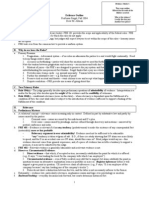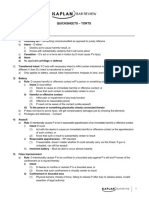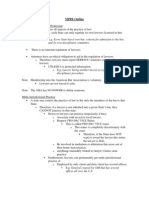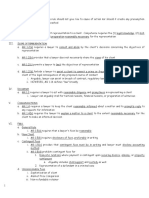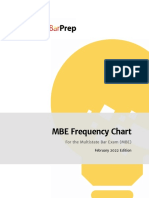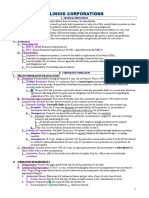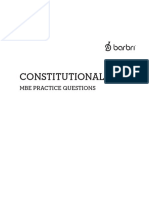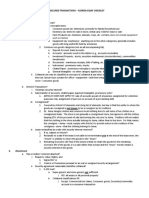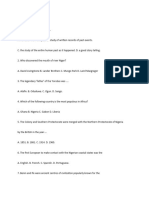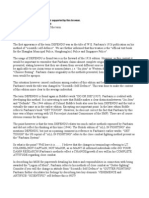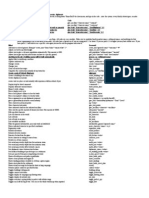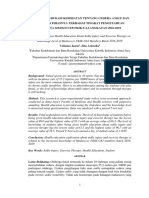Evidence Bar Outline
Evidence Bar Outline
Uploaded by
baller8586Copyright:
Available Formats
Evidence Bar Outline
Evidence Bar Outline
Uploaded by
baller8586Original Description:
Copyright
Available Formats
Share this document
Did you find this document useful?
Is this content inappropriate?
Copyright:
Available Formats
Evidence Bar Outline
Evidence Bar Outline
Uploaded by
baller8586Copyright:
Available Formats
EVIDENCE
I. RELEVANCE
A. LOGICAL RELEVANCE: evidence is relevant if it has any tendency to make
the existence of any fact of consequence more or less probable than it
would be without the evidence
I. CEC: fact of consequence must be in dispute
B. LEGAL RELEVANCEPROBATIVE/PREJUDICE BALANCE: even if evidence is
logically relevant, court has discretion to exclude if probative value is
substantially outwei!e" by unfair preudice, confusion, or waste of
time.
!. "#$%!& '(A)#*) +#' (,!$-)%#* #+ '($(.A*/ (.%0(*!(
I. Liability Insu#an$e: inadmissible to prove culpable conduct 1e.g.,
*egligence2 or 03s ability to pay a udgment, but admissible for any
other purpose 1bias, impeachment, ownership, scope of
employment2.
II. %ubse&uent Re'e"ial (easu#es: inadmissible to prove culpable
conduct or defective product design, but admissible for any other
purpose 1including to rebut defense of no feasible precaution or
destruction of evidence2
1. CEC: admissible for defective product design, but not
negligence
III. %ettle'ents) O*e#s to %ettle) Pleas: all statements and all
related statements made in settlements, o4ers to settle, and pleas
are inadmissible to prove liability in civil case or guilt in criminal
case, unless 152 no claim yet asserted or 162 no dispute as to
liability or damages
1. CEC: discussions during mediation also inadmissible
IV. Pay'ent o# O*e#s to Pay (e"i$al E+,enses: inadmissible to
prove liability for inuries, but admissible for all other purposes.
-nlike settlements, related statements are admissible.
1. CEC: related statements not admissible
V. CEC: (xpressions of sympathy relating to su4ering or death of
accident victim inadmissible in civil case, but statements of fault
within expression are not excluded
0. 7(*('A$ '-$(
I. 7enerally evidence must relate to time, event, or person in
controversy to be relevant.
II. (xception: %i'ila# O$$u##en$esevidence about persons or
events other than those directly in issue are )#8(/%8() relevant.
(. )%8%$A' #!!-''(*!()
I. To P#o-e Causation: similar accident or inuries by same event or
condition admissible to prove causation 1e.g., B ate same food at
same restaurant at same time as A, and both got sick9 B3s illness
admissible to prove restaurant caused A3s illness2.
1
II. P#io# A$$i"ents o# Clai's
1. 7eneral 'ule: irrelevant, so inadmissible
2. (xceptions: 152 pattern of fraudulent claims9 162 preexisting
condition 1to show present accident didn3t cause inury2
III. To P#o-e Intent. previous similar acts admissible to prove intent
1e.g. pattern of discrimination2.
IV. To Rebut De/ense o/ I',ossibility
V. Co',a#able %ales Rele-ant to Establis! Value 1where value of
property is an issue2
VI. 0abit: relevant to show person acted in accordance with the habit
on occasion in question
1. :abit v. !haracter: habit describes speci;c conduct with no
moral udgment, whereas character evidence is more general
and does convey a moral udgment
2. +requency: habit must be frequently repeated conduct 1not
ust a couple times2
VII. Routine Business P#a$ti$e: relevant to show that conduct of the
entity was in conformity with that practice on the occasion in
question 1habit of business2
VIII. In"ust#ial Custo': relevant to prove standard of care in
negligence case 1not conclusive2
II. C0ARACTER EVIDENCE
A. A*A$&/%!A$ +'A8(<#'=
I. )tep 5: ,u#,ose for which character evidence is o4ered 1to prove
conduct9 character is at issue9 impeach>support credibility of a
witness2
II. )tep 6: 'et!o" or technique used to prove character 1speci;c
acts9 opinion, reputation2
III. )tep ?: $i-il o# $#i'inal case
IV. )tep @: evidence must prove a ,e#tinent $!a#a$te# t#ait
B. !%.%$ !A)()
I. To P#o-e Con"u$t
1. 7eneral 'ule: character evidence is inadmissible to prove
conduct
2. (xception: sexual assault or child molestation claim
a. CEC: no exceptions
II. C!a#a$te# in Issue:
1. 'ule: character evidence admissible via all methods
2. <hen: defamation, negligent entrustment, child custody
disputes
!. !'%8%*A$ !A)()
I. I'ae: two doors to admissibility of character evidence to prove
conduct of 0 and .9 both are closed when prosecution begins its
caseAinAchief9 usually only 0 can open them, and usually they are
opened separately
2
II. Gene#al Rule
1. 0efense can be ;rst to open the door as to character, not
prosecution. %f 0efense opens door, prosecution can o4er
pertinent character evidence to rebut.
III. To P#o-e D1s Con"u$t
1. 7eneral 'ule: prosecution can3t be the ;rst to o4er character
evidence to prove 03s conduct, but if 0 opens the door,
prosecution can then o4er pertinent character evidence to
rebut
2. (xceptions: prosecution can open door 152 if sexual assault or
child molestation9 162 where court has admitted evidence of
.3s character o4ered by 0, prosecution can be ;rst to o4er
evidence that 0 has same character trait
a. CEC: domestic violence included in 152, and 162 limited
to violent character
3. 8ethod
a. #n direct, only reputation and opinion evidence, no
speci;c instances
b. #n cross, can be reputation, opinion, or speci;c
instances
c. CEC: no speci;c instances on direct or cross, but
admissible under "rop B subect to ">" Balance
IV. To P#o-e V1s C!a#a$te#
1. 7eneral 'ule: prosecution can3t be ;rst to o4er evidence9 0
opens the door by 152 o4ering evidence of .3s character9 or
162 in a homicide case, 0 alleges . attacked ;rst 1prosecution
may be ;rst to o4er evidence3s of .3s character for
peacefulness2
a. CEC: "rop. B wipes out general rule that .3s door is
closed9 if evidence of .3s character is relevant, it3s
admissible subect to ">" Balance
2. 8ethod
a. #n direct, only reputation and opinion, but no speci;c
instances
i. CEC: allows speci;c instances on direct
b. #n cross, all methods available
V. Note: character never at issue in criminal case 1unlike civil case2
VI. Ra,e %!iel" %tatutes
1. !riminal 'ules: reputation and opinion evidence concerning .
inadmissible in a rape or sexual assault case9 speci;c
instances of .3s conduct admissible only to prove 152 third
party source of semen or inury or 162 prior consensual sex
between 0 and .
2. !ivil 'ules: reputation, opinion, and speci;c instances
evidence admissible if probative value substantially
outweighs unfair preudice 1but reputation only if . put her
reputation at issue2
VII. %,e$i2$ A$ts o/ (is$on"u$t To P#o-e Anyt!in Ot!e# T!an
D1s C!a#a$te#
3
1. 7eneral 'ule: )peci;c acts of misconduct inadmissible to
prove character, but admissible for any other purpose:
(I(IC
2. (I(IC: 8otive, %ntent, 8istake 1absence of2, %dentity 1similar
and unique2, !ommon "lan or )cheme
3. !ourt has discretion to exclude 8%8%! evidence for unfair
preudice 1">" Balance2
III. TE%TI(ONIAL EVIDENCE
A. !#8"(/(*!&
I. Re&ui#e'ents:
1. "ersonal knowledgeA witness 1<2 may testify to a fact only
if based on sensory perception
2. "resent recollection< must testify from present
recollection, not from a record regarding matters that < once
knew but now has forgotten.
3. !ommunication C< can relate perception9 and
4. )incerity#ath or aDrmation to tell truth
a. CEC: witness must understand legal duty to tell truth
II. Notes: 152 religious beliefs irrelevant9 162 no age requirement.
Eudge and members of ury cannot be witnesses.
III. 0y,nosis: witnesses hypnotiFed to refresh recollection are
competent
1. CEC: not competent unless in a criminal case where police
use procedures that protect against suggestion
B. #BE(!/%#*) /# +#'8
I. In Gene#al: must be timely and speci;c, otherwise waived
II. Ty,es:
1. Calls for Narrativequestions calls for a narrative
2. Unresponsiveresponse does not answer question asked
3. Leadingallowed on cross, but not on direct unless
adverse>hostile witness or witness needs help
4. Assumes Facts Not in Evidence
5. Argumentativelawyer not seeking an answer, but trying to
make an argument
6. Compoundtwo questions asked at the same time9 can
confuse ury since it is unclear answer refers to which
question.
!. <%/*()) -)( #+ 0#!-8(*/)
I. *ote: Anytime a < is using a doc during her testimony, watch for a
hearsay issue. 0ocs are out of court statements. Anytime a < is
reading from a doc to ury, it is a hearsay obection.
II. Re/#es!in Re$olle$tion: anything can be used to refresh, but
witness can3t ust read from the document. #pponent may inspect
it and o4er it into evidence.
III. Past Re$olle$tion Re$o#"e"
4
1. 0ef.: %f refreshing <3s recollection fails, a party can get
actual document into evidence, even though it is hearsay if
following elements are satis;ed.
2. (lements: 152 witness once had ,e#sonal 3nowle"e of the
facts9 162 document was 'a"e by witness, un"e# !is
"i#e$tion, or a"o,te" by him9 1?2 document
w#itten/a"o,te" when /a$ts we#e /#es! in witness3s
memory9 1@2 document was a$$u#ate when made9 and 1G2
witness now has insu4$ient #e$olle$tion to testify as to
matters contained in document
3. !onsequence: document is read to ury.
0. #"%*%#* /()/%8#*&
I. Gene#al Rule: inadmissible because personal knowledge lacking.
/wo exceptions for lay opinion and expert opinion.
II. Lay O,inion
1. 'ule: Admissible if #ationally base" on witness1s
,e#$e,tions and !el,/ul to trier of fact9 can3t be based on
scienti;c or other specialiFed knowledge
2. 'equirements: 152 <3s perception 1lay opinion must be based
on <3s perception29 162 rationally related on <3s perception
1logical relationship b>w perception and opinion29 and 1?2
helpful to trier of fact 1tells ury more than if testimony were
limited to facts perceived2.
3. Acceptable: speed of auto, sanity, intoxication, emotions,
value of witness3s property
4. *ot Allowed: legal conclusions
III. E+,e#t O,inion
1. 'equirements: 152 opinion !el,/ul to ury 1used specialiFed
knowledge average uror couldn3t ;gure out on his own29 162
witness &uali2e"9 1?2 witness believes opinion to reasonable
"e#ee o/ $e#tainty9 1@2 opinion supported by proper
/a$tual basis9 and 1G2 opinion based on #eliable ,#in$i,les
#eliably a,,lie" 1CEC: generally accepted principles in
;eld2
2. +actual Basis of #pinion: #pinion may be based on 152
admitted evidence9 162 personal knowledge9 1?2 inadmissible
evidence reasonably relied on by people in that profession
3. 'eliability +actors: Daubert %tan"a#": 152 peer reviewed
and published9 162 tested and subect to retesting9 1?2 low
error rate9 1@2 reasonable level of acceptance
a. CEC: Kelley-Frye %tan"a#": only one factor: opinion
must be based on principles generally accepted by
experts in the ;eld
4. $earned /reatise: admissible to prove anything stated therein
if it3s an a$$e,te" aut!o#ity in the ;eld 1exception to
hearsay2. !an be used for impeachment or substantively.
5
a. CEC: only admissible to show matters of general
notoriety or interest
(. (.%0(*!( #+ <%/*()) !'(0%B%$%/&
I. To %u,,o#t C#e"ibility
1. 7eneral 'ule: inadmissible unless credibility attacked ;rst
2. "reA8otive !onsistent )tatement: admissible for all purposes
if made before b#ibe or in$onsistent statement9 otherwise
inadmissible for any purpose
a. :earsay (xemption: )ince prior consistent statement
is exempt from def of hearsay, it is admissible both to
support <3s credibility and substantively.
II. I',ea$!'ent 16 step approach2
1. )ource%s the source of impeachment extrinsic evidence
1any evidence other than testimony of < being impeached2
or cross of < being impeachH
2. Admissibility of ((%f extrinsic, is it admissible given
impeachment techniqueH
III. Te$!ni&ues o/ I',ea$!'ent
1. !ontradiction: )howing that some fact that < uttered is not
true. !an3t use extrinsic evidence to impeach on $ollate#al
'atte#, but admissible to for material matter.
2. "rior %nconsistent )tatement
a. 7eneral 'ule(xtrinsic evidence inadmissible to
impeach on collateral matter. %f material matter,
extrinsic evidence admissible only if witness given an
opportunity to explain or deny
b. :earsay "roblem"%) of witness who testi;es at trial
not hearsay if under oath at prior trial or deposition
1also allowed for impeachment2
i. CEC: hearsay, but admissible under exception,
which extends to all prior inconsistent
statements even if not under oath
3. Bias, %nterest, 8otive: extrinsic evidence admissible if witness
given opportunity to explain or deny
4. "rior !onviction for !rime %nvolving +alse )tatement: all
convictions 1felony or misdemeanor2 for crimes of /alse
state'ent 1perury, forgery, fraud2 are admissible, and court
won3t do ">" Balance unless crime I 5J years ago
a. CEC: all felonies involving 'o#al tu#,itu"e 1general
readiness to do evil9 e.g., lying, violence, theft, sexual
misconduct2 admissible subect to ">" Balance9 all
other felonies inadmissible 1not relevant if no moral
turpitude2
b. CEC: misdemeanor convictions inadmissible to
impeach, but "rop B allows it in criminal case if crime
of moral turpitude
5. !onviction for !rime *ot %nvolving +alse )tatement: felonies
admissible to impeach, but court may exclude for unfair
preudice. 8isdemeanors inadmissible to impeach.
6
a. CEC: inadmissible unless moral turpitude
6. *onA!onviction 8isconduct Bearing on /ruthfulness:
admissible to impeach in both civil and criminal cases if acts
involved lying9 no extrinsic evidence allowed but can ask
witness about misconduct on cross
a. CEC: inadmissible under !(!, but "rop B makes
admissible in criminal cases if relevant9 both cross and
extrinsic allowed, subect to ">" Balance
7. 'eputation and #pinion 'egarding /ruthfulness: Admissible to
impeach. 8ay use extrinsic evidence.
IV. 0EAR%A5
A. 0(+%*%/%#*: out of court statement o4ered to prove the truth of the matter
asserted therein
I. )tatement K verbal, written or assertive conduct
II. )tatement must be by a person 1not animal or machine2
B. CEC. "'#". B %*A""$%!AB$(
I. "rop. B does not apply to hearsay, i.e., hearsay rules apply in
criminal cases involving crimes of moral turpitude.
!. *#*A:(A')A&
I. %ndependent $egal )igni;cance
II. #4ered to show e4ect on listener 1e.g. notice, distress2
III. #4ered to show speaker3s knowledge of facts stated
IV. !ircumstantial evidence of state of mind 1e.g. insanity2
0. (,(8"/%#*) 1*otA:earsay2
I. A"'ission o/ Pa#ty O,,onent: statement constituting an
admission by a party opponent9 doesn3t have to be against interest
when made9 no personal knowledge requirement
1. CEC: hearsay, but admissible under exception
2. Vi$a#ious Pa#ty A"'issions
a. )tatement by 152 authoriFed spokesperson or 162
employee concerning matter within scope of
employment made during employment relationship
b. AuthoriFation can be express or implied
c. Adoptive Admission: nonparty makes statement,
and party acts as if it3s true
d. Co-Conspirator tatement: made during course and
in furtherance of conspiracy
e. CEC: narroweremployer responsible for employee3s
words only if also responsible because of that
employee3s conduct
II. P#io# in$onsistent state'ent un"e# oat! 1declarant testi;es at
trial2
1. CEC: hearsay, but falls within exception, even if not under
oath
7
III. P#io# $onsistent state'ent o4ered to rebut charge of recent
fabrication, improper inLuence or motive 1declarant testi;es at trial2
1. CEC: hearsay, but falls within exception
IV. %tate'ent o/ i"enti2$ation of a person made after perceiving
person 1to protect 03s rights, declarant < must testi;es at trial and
be subect to cross2
1. CEC: hearsay, but falls within exception
(. (,!("/%#*) 1Admissible :earsay2
I. 'equiring -navailability 1privilege9 contemptuous refusal9 lack of
memory9 death or in;rmity9 absent from hearing2
a. CEC: no contemptuous refusal9 must be total memory
loss9 also if declarant refuses to testify out of fear
5. 6o#'e# Testi'ony: /estimony given in earlier proceeding or
deposition by a person now unavailable is admissible if:
a. "arty against whom it3s o4ered had an opportunity and
similar motive to examine the declarant at prior
proceeding, or
b. %n a civil case, party against whom it3s o4ered wasn3t
present but had a close privityAtype relationship with a
party who did have opportunity and similar motive
i. CEC: no privity requirement, ust someone with
same opportunity and interest at prior
proceeding9 or former testimony o4ered against
person who o4ered it on own behalf before
6. De$la#ation Aainst Inte#est: admissible if against
;nancial or penal interests when made9 doesn3t have to be a
party9 if o4ered to exculpate accused 1i.e., by showing
someone else did the crime2, must have corroborating
evidence to admit it
a. CEC: includes statements against social interest 1risk
making declarant obect of hatred, ridicule, or social
disgrace in community2
?. Dyin De$la#ation: admissible in 152 civil action or homicide
case if 162 unavailable declarant believed he was about to die
and 1?2 statement describes the cause or circumstances of
the impending death
a. CEC: applies in all civil and criminal cases, but
declarant must be dead
II. E+$ite" Utte#an$e: statement relating to startling event or
condition is admissible if made while declarant still under stress of
exciting event 1does not have to be immediate, as long as still
under stress of event2
III. P#esent %ense I',#ession: admissible if describing an event
while declarant was perceiving the event or immediately thereafter
1. CEC: narrower9 must be statement explaining conduct of
declarant made while declarant was engaged in that conduct
8
2. CEC: M#E (xceptionN: statement describing inLiction or threat
of physical abuse by an unavailable declarant 1possible
!onfrontation !lause obection2
IV. De$la#ation o/ T!en E+istin P!ysi$al o# (ental Con"ition o#
%tate o/ (in": admissible to show the condition or state of mind,
as well as action in accordance therewith 1but statement describing
a memory or belief is not admissible to prove fact remembered or
believed 1e.g. M% remember>believe that 0 shot victimN not
admissible to prove 0 shot victim22.
V. Past o# P#esent (ental o# P!ysi$al Con"ition (a"e /o#
Pu#,ose o/ (e"i$al Dianosis o# T#eat'ent: statement is
admissible if made for medical diagnosis or treatment 1includes
statement of cause if pertinent2
1. CEC: in addition, only if declarant is a minor describing an
act of child abuse or neglect
2. CEC: statement of unavailable declarant3s past physical or
mental condition is admissible to prove that condition if it is
an issue in the case, even if not made for medical purposes
VI. Business Re$o#"s
1. (lements: 152 record of events, conditions, opinions or
diagnoses9 162 kept in course of regularly conducted business
activity9 1?2 made at or near time of matters described9 1@2
by person with knowledge of the facts in that record9 1G2 and
it was regular business practice to make such record
2. *ote: can cover multiple layers of hearsay
VII. Publi$ Re$o#"s
1. 'ecord of public oDce admissible in criminal or civil case if
152 it describes activities of the oDce
2. Also admissible in civil case if record 162 describes matters
observed pursuant to duty imposed by law9 or 1?2 contains
factual ;ndings resulting from investigation made pursuant
to authority granted by law, unless untrustworthy
3. CEC: doesn3t have same restrictions on prosecution9 record
admissible if 152 made by public 162 within scope of duties 1?2
made at or near time of matters described, and 1@2
circumstances indicate trustworthiness
VIII. Ju"'ent o/ P#io# 6elony Con-i$tion: copy of udgment
admissible to prove any material fact to the udgment, but
prosecution can3t o4er udgments against persons other than the
accused except for impeachment
1. CEC: exception applies only in civil cases, but "rop B permits
prosecutor or 0 in criminal case to impeach witness with
criminal conviction involving moral turpitude
+. !#*+'#*/A/%#* !$A-)(
I. (xcludes: !onfrontation !lause prohibits 152 use of an out of court
testimonial statement 1testimonial K made during court and
intended to further a police investigation2 162 by a declarant who
does not testify at trial 1?2 and is now unavailable, 1@2 where 0 had
9
no chance to cross declarant about the statement when it was
made
II. *otes: 152 only an issue in criminal cases9 162 only an issue where
prosecution seeks to introduce evidence9 1?2 statements to deal
with an ongoing emergency are allowed
III. !A3s M#E (xceptionN8ay run afoul of !! b>c declarant unavailable
and statement made to police.
V. 7RITING% AND OT0ER P05%ICAL EVIDENCE
A. A-/:(*/%!A/%#*
I. Gene#al Rule: every item of nonAtestimonial evidence must be
authenticated, meaning that it is what its proponent claims it to be
1low burden: MsuDcient to sustain ;ndingN2
II. %inatu#e Aut!enti$ation: <ays to authenticate a signature on a
document 152 admission 1by signor29 162 eyewitness testimony 1by
witness who saw 0 sign29 1?2 expert opinion 1compares disputed
signature to genuine example29 1@2 lay opinion 1has seen 0 sign his
name elsewhere29 1G2 circumstantial evidence 1circumstances are
such that a reasonable person would conclude that 0 signed29 1O2
genuine exemplar 1genuine signature admitted, and ury compares
to disputed signature2
III. An$ient Do$u'ents: authenticated if 152 at least 6J years old
1CEC: ?J years29 162 no facial irregularities 1erasures29 and 1?2 found
where you would expect to ;nd such documents
IV. %el/8Aut!enti$atin 7#itins: 152 certi;ed copies of public
documents 1deeds29 162 acknowledged documents 1notariFed29 1?2
oDcial publications 1gov3t pamphlets29 1@2 newspapers and
periodicals9 1G2 business records9 1O2 trade inscriptions 1tag or label
attached during course of business that indicates ownership,
control, or origin2
1. CEC: business records and trade inscriptions not selfA
authenticating
V. P!otos: witness needs personal knowledge, but doesn3t have to be
photographer
1. Acceptable: does photo fairly and accurately depict the scene
of the accidentH 1don3t need photographer2
2. *ot Acceptable: is this a photo of the scene at time of
accidentH 1photographer required2
VI. Aut!enti$ation o/ Non8Uni&ue Ite's: +acially indistinguishable
from other like items. $ay !"ain o# !ustody9 minor breaks ok
B. B()/ (.%0(*!( '-$( 1!A: M )(!#*0A'& (.%0(*!( '-$(N2
I. A,,li$ability: evidence o4ered to prove contents of a writing 1e.g.
case turns on contents of legal instrument, or knowledge obtained
from writing2
II. Co''on E+a',les: contracts, wills, deeds
III. Note: MwritingN includes any tangible collection of data 1video,
photo, xAray, audio recording, computer disk2
10
IV. Gene#al Rule/o prove terms of a writing, the original must be
produced if terms of writing are material.
V. Volu'inous Do$u'ents E+$e,tion: witness can summariFe a
large volume of documents as long as originals are available for
inspection by the other side
VI. A"'issible E-i"en$e
1. $ri%inals 1including computer printouts and certi;ed copies
of public documents2
2. Dupli!ates 1carbon copy or photocopy, but not handwritten
copy2
a. (xception: duplicate not admissible where there is
genuine question as to original3s authenticity 1claim
original was tampered with or altered2
b. CEC: admits duplicates and other written evidence of
contents of original, such as handwritten notes
3. &estimony regarding contents of writing may be admissible
where original lost or destroyed, unless bad faith by
proponent of testimony
VII. CEC: called the %e$on"a#y E-i"en$e Rule
VI. PRIVILEGE%
A. !A: "'#". B %*A""$%!AB$( /# "'%.%$(7()
I. "rop. B inapplicable to privileges, i.e., usual !(! rules apply in
criminal case.
B. A//#'*(&A!$%(*/
I. Gene#al Rule: communication between attorney and client or their
representatives intended by client to be con;dential and made to
facilitate legal services is privileged in all civil and criminal
proceedings unless waived by client
II. Co#,o#ations: privilege applies to communications from
employees>agents if the corporation authoriFed the employee>agent
to communicate to the lawyer
1. CEC: privilege applies if employee>agent is the natural
person to speak to the lawyer on behalf of corp. in the
matter, or did something for which corp. could be held liable
and corp. told him to tell lawyer 1same result in application
as federal rule2
III. *eed not form attorneyAclient relationship, but must have intent or
formal e4ort to do so
IV. Du#ation: survives termination of relationship or death
V. 0ol"e# o/ P#i-ilee: Atty may claim privilege on client3s behalf.
1. CEC: Atty must claim privilege on client3s behalf.
VI. E+$e,tions
1. Crime'Fraud: professional services sought to further what
client knew or should have known to be a crime or fraud
2. (rea!" o# Duty: communication relates to alleged breach of
duty by lawyer
11
3. Common )nterest: two or more parties consult attorney on
a matter of common interest and the communication is
o4ered by one of these parties against the other
4. CEC: Dane#ous Client: lawyer reasonably believes
disclosure is necessary to prevent crime that is likely to result
in death or substantial bodily harm
!. )"#-)A$
I. Testi'onial P#i-ilee: permits witness to refuse to testify against
his>her spouse in criminal case about anything
1. /iming: only need to be married at time of trial 1not at time
of crime2
2. :older: witness 1not other spouse2
3. CEC: applies in civil and criminal cases9 spouse is privileged
to not even be called to witness stand
II. Con2"ential Co''uni$ation P#i-ilee: protects con;dential
spousal communications during marriage.
1. /iming: must be married at time of statement 1but need not
be married at trial2
2. :older: both spouses hold privilege
0. ")&!:#/:('A"%)/A"A/%(*/: communication intended by patient to be
con;dential made to facilitate rendition of professional psychological
services is privileged in all civil and criminal proceedings unless waived by
patient
I. (xceptions: %napplicable 152 in malpractice suit b>w patient
psychotherapist 1or doctor2 and 162 cases here patients puts
physical or mental condition at issue.
II. CEC: does not apply if psychotherapist has reasonable cause to
believe patient is a danger to himself or others and disclosure is
necessary to end that danger. Also has 0octorA"atient privilege, but
not +ederal rules.
(. )#!%A$ <#'=('A!$%(*/: communication intended by client to be con;dential
made to a social worker to facilitate rendition of professional psychological
services is privileged in all civil and criminal proceedings unless waived by
client
+. CEC: A00%/%#*A$ "'%.%$(7()
I. Do$to#8Patient P#i-ilee
1. 7eneral 'ule: patient has privilege to prevent disclosure of
con;dential information revealed to physician for purpose of
obtaining diagnosis or treatment and info was pertinent to
diagnosis or treatment
2. (xceptions: 152 patient puts his physical condition in issue
1personal inury suit29 162 physician3s services sought to aid in
crime or fraud9 1?2 case alleging breach of duty arising out of
relationship 1malpractice2
3. 0oes not apply in criminal cases or to info doctor required to
report to public oDce
12
II. Counselo#8Vi$ti' of )exual Assault or 0omestic .iolence
III. Cle#y8Penitent
IV. %mmunity from contempt for news #e,o#te# who refuses to
disclose sources
7. A""$%!AB$( $A<: state privilege rules apply in federal civil diversity actions
VII. Ju"i$ial Noti$e
A. 0e;nition"rocess of establishing facts w>o presenting evidence.
B. +A!/) A""'#"'%A/( +#' E-0%!%A$ *#/%!(: facts not subect to reasonable
dispute because they are either 152 generally known within the urisdiction
or 162 capable of accurate and ready determination by resort to sources
whose accuracy cannot reasonably be questioned
!. "'#!(0-'( +#' /A=%*7 E-0%!%A$ *#/%!(: court has discretion to take it, or
party can request it9 in civil case ury must accept noticed fact as
conclusive, but in criminal case ury may, but is not required to, accept it9
udicial notice may occur at any time, even on appeal
VIII. CALI6ORNIA DI%TINCTION%
A. "'#"#)%/%#* B: /'-/: %* (.%0(*!( A8(*08(*/
I. 8akes all relevant evidence admissible in a criminal case, even if
obectionable under !(!
II. "rop B does not apply to 152 !onfrontation !lause9 162 hearsay9 1?2
privileges9 1@2 rape shield laws9 1G2 rule prohibiting prosecution from
o4ering evidence of 03s character before 0 opens door9 1O2
)econdary (vidence 'ule 1Best (vidence29 and 1P2 !(! ?G6 1">"
Balance2
B. A*A$&/%!A$ +'A8(<#'=
I. )tep 5: raise all obections under !(!
II. )tep 6: for each obection, mention if "rop B overrules the obection
1if evidence is relevant and no exception applies, evidence is
admissible2
III. )tep ?: if evidence seems admissible under "rop B, do ">" Balance
under !(! ?G6
I9. TIP% 6OR E%%A5
A. #rganiFe by evidentiary %tem
B. )tate purpose of the evidence
!. )tate A$$ possible obections and de;nition>rule
0. 'elate evidentiary item in facts to de;nition. Apply rule to the facts.
(. *#/(: %f !A evidence essay Q criminal case, remember to apply "rop. B.
13
+. *#/(: (vidence essays raise many issues, so keep analysis concise and
be little more conclusory.
14
You might also like
- 2020 National Conference of Bar Examiners (NCBE) Civil Procedure Sample MBE Questions Question # 1Document24 pages2020 National Conference of Bar Examiners (NCBE) Civil Procedure Sample MBE Questions Question # 1LALA100% (1)
- MBE-Con Law OutlineDocument31 pagesMBE-Con Law OutlineStacy Oliveira100% (4)
- MBE - Real Property OutlineDocument35 pagesMBE - Real Property OutlineStacy OliveiraNo ratings yet
- Wills Bar OutlineDocument6 pagesWills Bar OutlineJohn Risvold50% (2)
- Backward Looking - Everyday Decisions Look Forward, But Courts Determine Historical FactDocument28 pagesBackward Looking - Everyday Decisions Look Forward, But Courts Determine Historical FactMegan Kelberman100% (1)
- Themis - Corporation OutlineDocument7 pagesThemis - Corporation OutlineParker BushNo ratings yet
- FL Vs MBE Tort DistinctionsDocument2 pagesFL Vs MBE Tort DistinctionsAndrew Reath100% (1)
- MBE QuickSheet TortsDocument14 pagesMBE QuickSheet TortsTania Ament100% (2)
- MPRE OutlineDocument14 pagesMPRE Outlineesquire1010No ratings yet
- PMBR Flash Cards - Contracts - 2007Document142 pagesPMBR Flash Cards - Contracts - 2007jackojidemasiadoNo ratings yet
- Checklist PRDocument8 pagesChecklist PRDouglas GromackNo ratings yet
- Torts LectureDocument25 pagesTorts LectureAlex Faris50% (2)
- MBE Karlan CrimproDocument30 pagesMBE Karlan CrimproAlexandraMarie100% (1)
- Defeasible Estates ChartDocument1 pageDefeasible Estates ChartMrsChuckBassNo ratings yet
- Wills Trusts BarDocument7 pagesWills Trusts BarroruangNo ratings yet
- Corporations MEE AttackDocument8 pagesCorporations MEE AttackAnnie Weikel YiNo ratings yet
- Civ Pro Attack OutlineDocument3 pagesCiv Pro Attack OutlineDee100% (1)
- Bar - Professional Responsibility OutlineDocument7 pagesBar - Professional Responsibility OutlineNaama ShemeshNo ratings yet
- Bar Prep - Outline - PR - ShortDocument12 pagesBar Prep - Outline - PR - ShortAnonymous Cbr8Vr2SX100% (1)
- MBE Subject Matter OutlineDocument8 pagesMBE Subject Matter OutlineSalam TekbaliNo ratings yet
- Ca Bar - Community PropertyDocument8 pagesCa Bar - Community PropertyAlexandra DelatorreNo ratings yet
- MBE TortsDocument8 pagesMBE Tortstconn8276100% (2)
- Pieper Bar ReviewDocument150 pagesPieper Bar ReviewJoanne Schioppi0% (2)
- SmartBarPrep MBE Frequency ChartDocument10 pagesSmartBarPrep MBE Frequency ChartJuseonParkNo ratings yet
- Community Property - Checklist (1) Basic Presumptions (You MUST Put This at The Top of EVERY Community Property Essay)Document3 pagesCommunity Property - Checklist (1) Basic Presumptions (You MUST Put This at The Top of EVERY Community Property Essay)Kat-Jean FisherNo ratings yet
- THEMIS LSE - TORTS RawDocument73 pagesTHEMIS LSE - TORTS RawKenyNo ratings yet
- Model AnswersDocument11 pagesModel AnswerszurainaNo ratings yet
- Quick Attack SheetDocument2 pagesQuick Attack SheetBrianStefanovicNo ratings yet
- Barbri Lect PropertyDocument12 pagesBarbri Lect PropertyJuliane Ashley MurphyNo ratings yet
- MBE Subject Matter Review ChecklistDocument3 pagesMBE Subject Matter Review Checklistbeebee83No ratings yet
- CrimPro Adjud OutlineDocument24 pagesCrimPro Adjud OutlineZackary Thomas GibbonsNo ratings yet
- Agency OverviewDocument14 pagesAgency OverviewmaddolaxNo ratings yet
- Crim. Law ATTACK Outline - Alschuler - Spring 2009 ChecklistDocument8 pagesCrim. Law ATTACK Outline - Alschuler - Spring 2009 ChecklistDaniel BarciaNo ratings yet
- Civil Procedure Mentor OutlineDocument7 pagesCivil Procedure Mentor OutlineLALANo ratings yet
- RD RD RD RDDocument11 pagesRD RD RD RDJaneNo ratings yet
- IL Corporations Bar OutlineDocument8 pagesIL Corporations Bar OutlineJulia NiebrzydowskiNo ratings yet
- Landlord Tenant Essay TemplateDocument8 pagesLandlord Tenant Essay TemplateTiffany HiceNo ratings yet
- Exam Outline Civ ProDocument24 pagesExam Outline Civ ProPuruda Amit100% (1)
- Civ Pro Rule Statements 2nd SemDocument15 pagesCiv Pro Rule Statements 2nd SemkoreanmanNo ratings yet
- Business AssociationsDocument13 pagesBusiness AssociationsJeremiahgibsonNo ratings yet
- PR OutlineDocument20 pagesPR Outlineddavis105No ratings yet
- MEE TEST CONCISE OUTLINE BAR ExaminationDocument21 pagesMEE TEST CONCISE OUTLINE BAR Examinationfun321goNo ratings yet
- Federal Civil Procedure OutlineDocument10 pagesFederal Civil Procedure Outlinefredtv100% (1)
- Nailing The Bar - How To Write Essay AnswersDocument432 pagesNailing The Bar - How To Write Essay AnswersGevork JabakchurianNo ratings yet
- Conviser Contracts OutlineDocument8 pagesConviser Contracts OutlinegrrrlprideNo ratings yet
- Corporations OutlineDocument20 pagesCorporations Outlinebaitkenh1626No ratings yet
- Defenses, StudicataDocument4 pagesDefenses, StudicatajaredNo ratings yet
- Eerie Flow ChartDocument1 pageEerie Flow ChartMissPardisNo ratings yet
- Rigos Bar Review Series "Uniform" Multistate Essay Exam (Mee) Review Federal Civil Procedure Magic Memory OutlinesDocument8 pagesRigos Bar Review Series "Uniform" Multistate Essay Exam (Mee) Review Federal Civil Procedure Magic Memory Outlinessomeguy813100% (1)
- Wills MnemonicsDocument6 pagesWills MnemonicsSemsudNo ratings yet
- MPT ChecklistDocument2 pagesMPT ChecklistMerve Ozcan100% (1)
- Con Law TestsDocument4 pagesCon Law Testschristell Casey50% (6)
- Business Association Outline Prof MockDocument31 pagesBusiness Association Outline Prof MockEvan SmithNo ratings yet
- Constitutional Law: Mbe Practice QuestionsDocument16 pagesConstitutional Law: Mbe Practice QuestionsStacy OliveiraNo ratings yet
- Sec. Trans.-Essay-ChecklistDocument4 pagesSec. Trans.-Essay-ChecklistNicole Marie Torres100% (1)
- Civil Procedure Rule SummariesDocument5 pagesCivil Procedure Rule SummariesAdrian PegueseNo ratings yet
- MPRE Unpacked: Professional Responsibility Explained & Applied for Multistate Professional Responsibility ExamFrom EverandMPRE Unpacked: Professional Responsibility Explained & Applied for Multistate Professional Responsibility ExamNo ratings yet
- Introduction To SubtitlingDocument6 pagesIntroduction To Subtitlingamel.elnasharNo ratings yet
- Chapter 1 - Introduction of ScienceDocument27 pagesChapter 1 - Introduction of SciencenixleonNo ratings yet
- 08 Workshop Transition From Defense To AttackDocument4 pages08 Workshop Transition From Defense To AttackAlfonso GonzalezNo ratings yet
- History WpsDocument4 pagesHistory WpsIgbomzyNo ratings yet
- Senate of The Philippines vs. ErmitaDocument40 pagesSenate of The Philippines vs. ErmitaSamantha NicoleNo ratings yet
- DefenduDocument2 pagesDefenduJandric Nebojsa-JimmyNo ratings yet
- Quiz Gaming System: Bachelor of Engineering IN Compuer Science and EngineeringDocument26 pagesQuiz Gaming System: Bachelor of Engineering IN Compuer Science and EngineeringKoveNo ratings yet
- DREAM TEAM PAPER MAIN 1 030718 FinalDocument69 pagesDREAM TEAM PAPER MAIN 1 030718 FinalAllyssa Jane ErcillaNo ratings yet
- Power Grid-India-Annexure-II-Specific-Requirement - Rev-05 - With-Annexures-1-11Document11 pagesPower Grid-India-Annexure-II-Specific-Requirement - Rev-05 - With-Annexures-1-11Jose ValdiviesoNo ratings yet
- 07 Chapter 1Document40 pages07 Chapter 1k.touilebNo ratings yet
- Potential Failure Mode and Effect Analysis: (Pfmea)Document2 pagesPotential Failure Mode and Effect Analysis: (Pfmea)Mohit KaushikNo ratings yet
- UEL-SG-7001 - Week 3 - Discussion Forum - Task 1 - Bowman's Strategy ClockDocument2 pagesUEL-SG-7001 - Week 3 - Discussion Forum - Task 1 - Bowman's Strategy ClockNea MillsNo ratings yet
- OOO The Word Center: Love Is Our HeadquartersDocument39 pagesOOO The Word Center: Love Is Our HeadquartersNkor IokaNo ratings yet
- Microprocessor and Assembly LanguageDocument36 pagesMicroprocessor and Assembly LanguageIqraNo ratings yet
- EBS-올림포스-독해의기본1 한줄해석쓰기 unit18 장문 학생용 아잉카아카데미Document8 pagesEBS-올림포스-독해의기본1 한줄해석쓰기 unit18 장문 학생용 아잉카아카데미t31776284No ratings yet
- Influence of Rock Mass Parameters in Optimal Design of Rock BlastingDocument14 pagesInfluence of Rock Mass Parameters in Optimal Design of Rock BlastingIka May HartatiNo ratings yet
- CPEC101GROUPCASESTUDYdiscussion SheetDocument4 pagesCPEC101GROUPCASESTUDYdiscussion SheetYoru JettNo ratings yet
- G.R. No. 192251 16 February 2011 Velasco, J.: People V. TomasDocument2 pagesG.R. No. 192251 16 February 2011 Velasco, J.: People V. TomasKarla BeeNo ratings yet
- Rome Total War CheatDocument2 pagesRome Total War CheatYolly Yamaki Yamaki100% (1)
- Open Innovation - Davit DanelidzeDocument3 pagesOpen Innovation - Davit DanelidzeDavit DanelidzeNo ratings yet
- UnitimeDocument35 pagesUnitimevijay_marathe01No ratings yet
- Table of Specification First Periodical Test Mathematics Iv S.Y 2018-2019Document9 pagesTable of Specification First Periodical Test Mathematics Iv S.Y 2018-2019HANNA GALE100% (2)
- Activate Prior Knowledge 4: The Concept of FunctionDocument7 pagesActivate Prior Knowledge 4: The Concept of FunctionKzy ayanNo ratings yet
- Cationic and Amphoteric SurfactantsDocument9 pagesCationic and Amphoteric SurfactantsUtkarsh MankarNo ratings yet
- uid phụ huynh trường tiểu học và trung học Vinschool (Hà Nội)Document657 pagesuid phụ huynh trường tiểu học và trung học Vinschool (Hà Nội)Toản PhạmNo ratings yet
- Stratospheric Communication Platforms As An Alternative For Space Program PDFDocument7 pagesStratospheric Communication Platforms As An Alternative For Space Program PDFVictor LiNo ratings yet
- Ratna Sagar Academy Long PosterDocument1 pageRatna Sagar Academy Long PosteralizaNo ratings yet
- Hubungan Tingkat Pengetahuan Tentang Cedera Ankle Dan Terapi Latihannya Terhadap Tingkat Pengetahuan Anggota Medsoccer Fkik-Uaj Angkatan 2016-2019Document9 pagesHubungan Tingkat Pengetahuan Tentang Cedera Ankle Dan Terapi Latihannya Terhadap Tingkat Pengetahuan Anggota Medsoccer Fkik-Uaj Angkatan 2016-2019Jason YohanesNo ratings yet
- The Solubility of DrugsDocument38 pagesThe Solubility of Drugsmoney in the bankNo ratings yet




